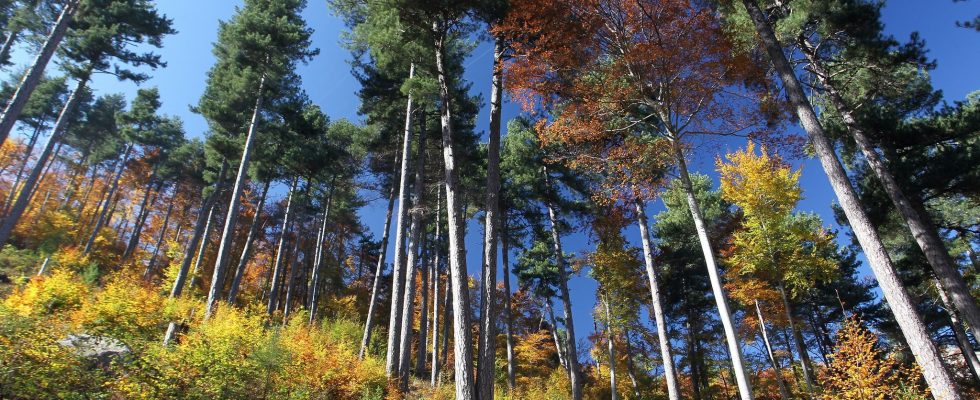The French forest continues to expand – and we can rejoice about it. Its surface reached 17.1 million hectares in 2022, according to data from the National Institute of Geographic and Forest Information (IGN). That is an increase of 21% since 1985. The total volume of wood is also increasing, to 2.8 billion m³. But the “net” biological production, that is to say the growth of trees over a given period (mortality deducted), has slowed down by about 10% in a decade. Which leads to very bad news: the tricolor forests, as a whole, absorb half as much carbon as ten years ago. This is a worrying observation when forests remain essential for capturing CO2, and therefore for the fight against climate change.
“The carbon sink of forests almost doubled between 1990 and 2010. Since then, this reservoir has been decreasing: forests still absorb carbon, but in lesser quantities”, notes Philippe Ciais, director of research at the Laboratory of Climate and Climate Sciences. environment (LSCE). The researcher, who relies on the latest data (corresponding to the year 2020) of the Citepa (the organization mandated to carry out the French inventory of emissions), themselves based on the forest inventory of the IGN, has detailed trends by region. Balance sheet? Good forest health remains highly variable.
Corsica, whose territory is 65% covered by forests, shows a net loss. “It surprised me a lot because the forests there are thought to be natural and difficult to access. But they seem to be losing CO2 due to a strong intensification of harvesting.” In Brittany, mining is industrial. “We see that the region is at zero, whereas it was gaining carbon before,” laments Philippe Ciais, continuing the inventory of our wooded areas. The Normandy forests no longer pump CO2 and those of Auvergne are also approaching the limit threshold. The carbon sink of the former Rhône-Alpes region has fallen by 50% in a decade – but the territory remains the one where the absorption of forests is the strongest (around 6 million tonnes annually, the equivalent of 2 % of national fossil CO2 emissions according to the researcher).
Trees under stress
There are several reasons for the degradation of forest carbon sinks. “The growth of forests is decreasing. The trees, with the different episodes of drought, are under stress: they grow less and absorb less carbon”, explains François Morneau, technical advisor for the forest inventory at the IGN. Another underlying trend: an increase in tree mortality. “The annual flow of end-of-life species increased by more than 50% between the 2005-2013 and 2012-2020 periods,” notes IGN. The fault of droughts and heat waves – negative signals of the climate – but also of many insects, including bark beetles which ravage the spruce forests of a large northern part of the country. Chestnut trees are victims of ink disease; and the ash trees, chalarose.
The forests of the regions mentioned above “all record, to varying degrees, an increase in mortality, a stagnation in growth and an increase in harvest”, summarizes Philippe Ciais. These trends jeopardize compliance with the objectives of the national low-carbon strategy (SNBC), this tricolor roadmap aimed at conducting the climate change mitigation policy. “We are not at all on the right trajectory. If we rely on the forest to make France neutral, it will be complicated”, judges the scientist. “The effort to reduce emissions will be all the more important as the absorption of forests decreases”, abounds François Morneau. The High Council for the Climate already noted, last June, a 60% discrepancy between the “net sinks observed since 2010 and those anticipated by the SNBC”.
‘Contradictory goals’
This roadmap is based on two elements: maintaining carbon capture and stocks in forests, and “maximizing substitution effects and carbon storage in wood products”. That is to say, to use this material more, for example in construction, replacing concrete or steel, the production of which emits a lot of CO2. But in the eyes of the researcher specializing in the carbon cycle, the SNBC includes “contradictory objectives”. “We cannot allow stocks to increase at the same time – therefore having forests in free evolution, protecting them and harvesting less – and extracting ever more to replace building materials with wood. There is a biological limit: doubling the well of carbon while doubling the extraction, it doesn’t work.”
In a study published in February 2022, the Institute for Climate Economics (I4CE) also criticizes this ambiguous strategy. He believes that “when it comes to the massive redirection of wood to longer-lived uses, the boundaries of realism are probably exceeded.” The report therefore recommends “reviewing the overall ambition downwards, depending on the effective and desirable harvesting possibilities, and the development of long-term uses of wood consistent with the possible outlets”, the sector not being strong enough. Because “in the event of failure, the bet on wood products, which supposes an increase in harvests, would only have the effect of damaging biological sequestration”, also warns Carbone4 consulting firm.
Still based on Citepa data, Philippe Ciais plays the game of predictions. Given the trend in recent years, the absorption capacity of our forests could fall to…zero in 2026! They could then release more carbon than they absorb. “It’s a completely questionable idea,” warns the researcher. Since the evolution of forests is far from linear, we cannot say anything.” But it is indeed a worrying scenario.
